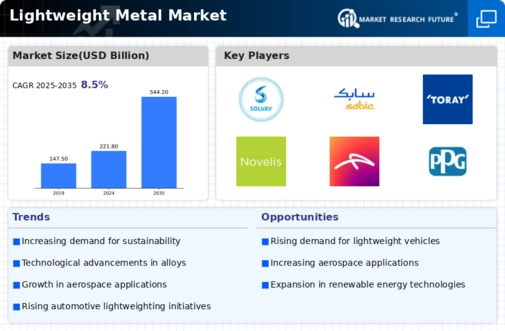Market Trends
Key Emerging Trends in the Lightweight Metal Market
The Lightweight Metal Market is currently experiencing dynamic trends that underscore the increasing demand for lighter and more efficient materials across various industries. One prominent trend is the growing adoption of lightweight metals, such as aluminum and magnesium, in the automotive sector. With an emphasis on fuel efficiency and the push towards electric vehicles, lightweight metals are becoming integral to the development of lighter and more energy-efficient automobiles. This trend aligns with the automotive industry's commitment to reducing emissions, enhancing performance, and improving overall vehicle efficiency by replacing traditional heavy materials with advanced lightweight alternatives.
Moreover, the aerospace industry is a major contributor to the momentum in the Lightweight Metal Market. The unique combination of strength and low density in lightweight metals makes them ideal for aircraft construction, leading to reduced fuel consumption and increased payload capacity. The aviation industry's focus on improving fuel efficiency, reducing carbon emissions, and enhancing overall performance is driving the increased use of lightweight metals in the production of aircraft components. This trend reflects the broader commitment to sustainability and eco-friendly practices in the aerospace sector.
Technological advancements in lightweight metal manufacturing processes are shaping market trends. Innovations such as advanced casting techniques, additive manufacturing, and alloy developments are improving the strength-to-weight ratios and performance characteristics of lightweight metals. This trend is crucial for meeting the evolving needs of industries where materials must withstand rigorous conditions while offering the advantages of reduced weight. The industry's focus on continuous innovation is driving the development of lightweight metal solutions that cater to diverse applications.
The consumer electronics sector is influencing trends in the Lightweight Metal Market. As electronic devices become more portable and compact, the demand for lightweight and durable materials is increasing. Lightweight metals, particularly aluminum and magnesium alloys, are preferred choices for manufacturing electronic components, casings, and structural parts. This trend aligns with consumer preferences for sleek and lightweight electronic devices, contributing to the miniaturization and portability of products in the electronics market.
Sustainability considerations are becoming increasingly important in shaping market dynamics in the Lightweight Metal Market. Manufacturers are exploring eco-friendly production methods, recycling initiatives, and sustainable sourcing of raw materials for lightweight metals. This trend aligns with the global movement towards environmentally responsible practices, reflecting the industry's commitment to reducing its environmental impact and meeting consumer expectations for sustainable and green materials.
E-commerce is playing a role in reshaping the distribution channels of lightweight metal products in the market. The convenience of online platforms for product discovery, comparison, and purchase is influencing buyer behavior, including in the lightweight metal sector. Manufacturers and distributors are adapting to this trend by enhancing their online presence, providing detailed product information, and offering efficient delivery services. The accessibility of lightweight metal products through e-commerce platforms contributes to increased market awareness and ease of procurement.
Regulatory considerations and adherence to safety standards are pivotal factors shaping market dynamics in the Lightweight Metal Market. As lightweight metals find applications in critical industries such as automotive and aerospace, compliance with regulations related to safety, quality, and performance is paramount. Companies are investing in research and development to ensure that their lightweight metal products meet or exceed regulatory requirements, providing assurances to consumers, businesses, and regulatory authorities.
Strategic collaborations and partnerships are emerging as trends in the Lightweight Metal Market. Companies are exploring synergies through joint ventures, alliances, and collaborations to enhance research, development, and commercialization efforts. The collaborative approach allows for the exchange of expertise, resources, and market insights, fostering innovation and ensuring the continuous growth of the lightweight metal industry.











Leave a Comment